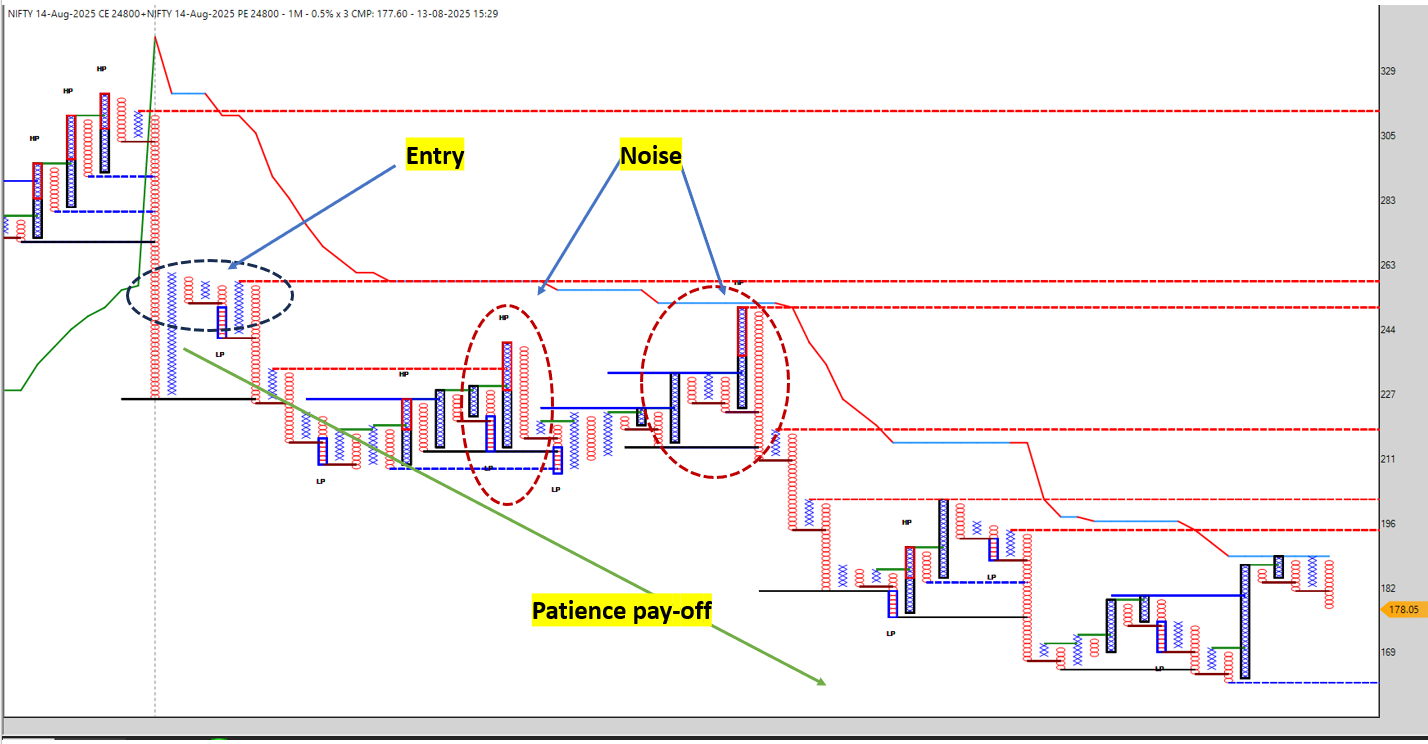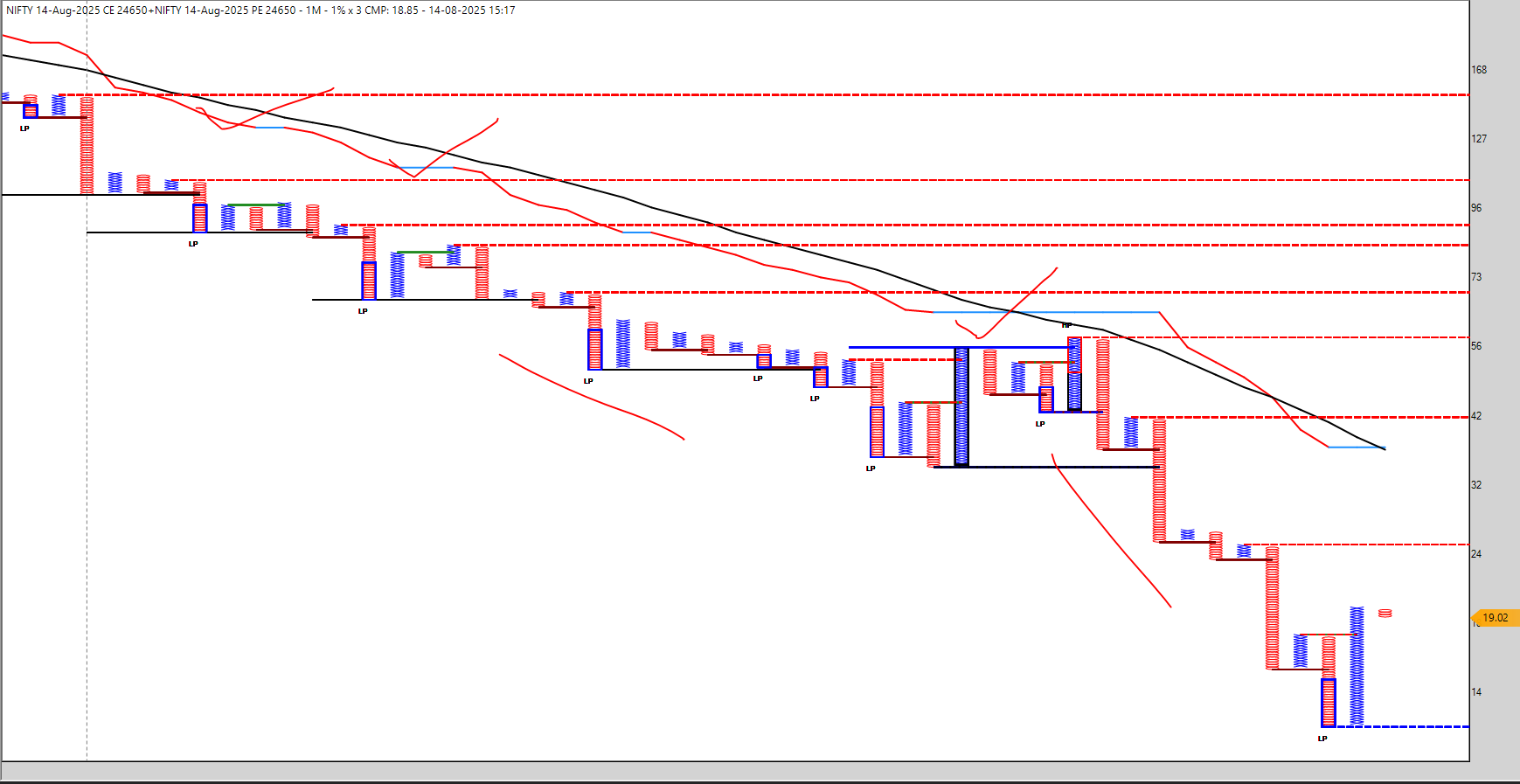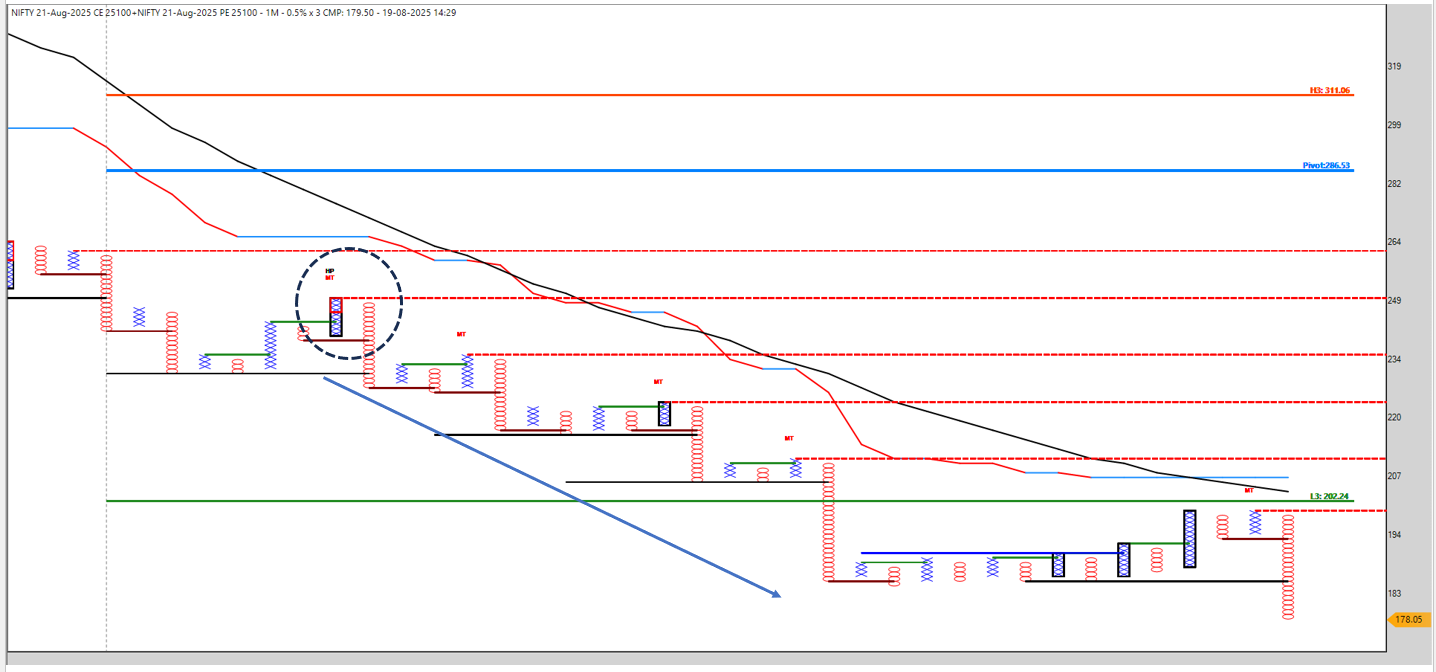
 Short Straddle Selling – Patience Beats the Noise :(A Case Study from a Live Chart)
Short Straddle Selling – Patience Beats the Noise :(A Case Study from a Live Chart)
-

(A Case Study from a Live Chart)
Option selling is not just about numbers — it’s about holding your ground when the market tries to shake you out.
In this study, we’ll dissect a real chart with marked Fear Traps and Patience Pays zones to understand how conviction and structure create long-standing winners.
 The Chart at a Glance
The Chart at a Glance- Red Shaded Areas = Fear Trap
Short-lived spikes designed to create emotional panic. - Green Shaded Areas = Patience Pays
Zones where holding the position led to significant option premium decay.
1️⃣ Understanding the Market’s “Fear Script”
a. Fear Trap #1
 Location: Red-circled spike after entry.
Location: Red-circled spike after entry.- What Happened: The market made a sudden upward push, breaking short-term highs.
- Psychological Attack: It tempts sellers to believe a breakout is coming, making them close early.
- Reality: Spike failed to sustain, and prices reverted back into decay zone.
b. Fear Trap #2
 Location: Red-circled spike.
Location: Red-circled spike.- What Happened: After a minor downtrend, market faked a recovery.
- Psychological Attack: Traders who survived the first trap think, “This is the real reversal.”
- Reality: It was a liquidity grab before another leg down.
2️⃣ The Power of Patience & Conviction
a. Patience Pays Zone #1
- Setup: After initial noise, market settled below key pivot lines.
- Why Hold: Price was below invalidation level, and time decay was accelerating.
- Result: Options lost value steadily even without huge directional moves.
b. Patience Pays Zone #2
- Setup: Post second fear trap, price structure aligned with your bias and VWAP acted as a ceiling.
- Why Hold: Consistent rejection at resistance confirmed sellers in control.
- Result: Massive premium collapse into the close.
3️⃣ The Technical Logic Behind the Hold
Element Role in Decision VWAP Served as dynamic SL. Price staying below confirmed no reversal. Pivot Levels Helped identify where fake breakouts might fail. Option Premium Behavior Time decay was visibly accelerating, signaling reward for holding. Market Structure Lower highs and lower lows showed sellers still active despite spikes.
4️⃣ Lessons for Freshers
Mistake to Avoid Better Approach Exiting at first spike Wait for SL/invalidation to hit before acting Chasing reversal after noise Let price confirm before switching bias Over-analyzing after entry Trust pre-trade analysis; monitor only key levels Ignoring decay factor Remember — in selling, sideways-to-down is your friend
 Final Takeaway
Final TakeawayOption selling rewards the trader who can see beyond the noise.
If your entry is based on sound structure, and you have a clear invalidation level, then patience becomes your profit engine.
Noise is inevitable — but decay is inevitable in your favor if the structure holds.
- Red Shaded Areas = Fear Trap
-
@SANTANU-BEZ you have mentioned these 2 things:
VWAP Served as dynamic SL. Price staying below confirmed no reversal.
Exiting at first spike Wait for SL/invalidation to hit before acting
But in reality, price crossed above the VWAP in both the situations. Isn't this contradictory? -
@Harjjap Singh Ssaini Got it

You basically want the comparison of Dynamic SL vs Entry After SL, but also showing that when the market is too noisy, it’s better to switch your SL method to Supertrend-based instead of VWAP-based, since VWAP can whipsaw you in choppy moves.Here’s the refined explanation:
Dynamic SL vs Entry After SL (with Supertrend Twist)
1. Dynamic SL

-
SL changes with market movement (trailing).
-
Normally, you might trail using VWAP, ATR, or pivots.
-
But in noisy markets (lots of wicks, sideways chop):
- Switch to Supertrend-based SL → It filters out small whipsaws better than VWAP.
- Supertrend smooths price action using ATR + trend direction.
- This keeps you in the trade longer while avoiding fake VWAP breaks.
Example:
- Short NIFTY 23,000 CE at ₹100.
- SL trails below Supertrend line (e.g., ₹112).
- Price spikes but stays under Supertrend → no exit.
- Big decay captured despite multiple VWAP whipsaws.
2. Entry After SL

-
You take a planned re-entry after your SL is hit, if the setup returns.
-
Supertrend can also help here:
- Wait until price comes back inside Supertrend trend direction before re-entering.
- Avoids immediate revenge trades after a false breakout.
Example:
- Short at ₹100, VWAP SL hit at ₹115.
- Price jumps, then falls below Supertrend again.
- Re-enter short at ₹112 with fresh SL at Supertrend level.
Comparison Table (VWAP vs Supertrend in Noisy Conditions)
Feature VWAP SL 
Supertrend SL 
Best For Trend + institutional bias days Noisy / choppy days Weakness Frequent whipsaws in sideways May delay exits in fast reversals SL Movement Follows intraday mean price Follows ATR-adjusted trend line Psychology Impact Can frustrate with false exits Keeps confidence by avoiding noise Re-entry Filter Needs extra confirmation Supertrend change acts as filter
 Pro Seller’s Formula:
Pro Seller’s Formula:- Trend Day → VWAP trailing SL (catches strong moves early).
- Noisy Day → Supertrend trailing SL (filters false moves).
- Always define pre-planned re-entry conditions—never improvise after a stop-out.
-
-
@Harjjap Singh Ssaini
 another exaple of today
another exaple of today -
@SANTANU BEZ said in

 Short Straddle Selling – Patience Beats the Noise :(A Case Study from a Live Chart):
Short Straddle Selling – Patience Beats the Noise :(A Case Study from a Live Chart):But in noisy markets (lots of wicks, sideways chop):
Switch to Supertrend-based SL → It filters out small whipsaws better than VWAP.
Supertrend smooths price action using ATR + trend direction.
This keeps you in the trade longer while avoiding fake VWAP breaks.@SANTANU-BEZ -> Got it. But we can't identify beforehand if the market today is going to be choppy or not. How do you decide this? Let's say SL is hit for vwap the first time (No follow through came). Second time follow through also came but didn't survive. So, do you wait for the followthrough? If followthrough comes after SL is hit the first time, then, exit, otherwise make supertrend the dynamic SL to be honored.

-
-
@SANTANU-BEZ ok, so in strong up/down trend i.e. financials, reliance, IT - all up/down together - using vwap, otherwise supertrend as trailing SL. Is my understanding correct?
-

